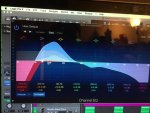Robot Sunsets
New member
Its a pop sounding song with a consistent bassy accompaniment. Not really a kick drum. Just bass line.
I eq the bass on the accompaniment track and bumped the original bass up pretty high, but it has a limiter and its compressed. The fader is pretty low. So theres a lot of power there.
Then I mixed it and bounced the whole song project to a wav and opened it in Ozone 6. Put the tight midrange preset and changed the eq around and balanced it more and added some stereo imaging and exciteness.
It sounds great on the KRK monitors, it sounds ok on laptop speakers (decently bassy), it sounds excellent on the surround stereo system in the theater, and good on headphones.
But then i played it in the car and dammit, there was some rattle on my stock speakers. The song sounds clean but just that rattle is there.
Ok so now to fix it, can I just put that mastered wav in logic, and put a simple low cut on the eq when I go to make an MP3? Or do I have to go back to the original track? Or maybe go back to Ozone? In Ozone I feel like I don't understand which eq to mess with. There are 3, one is pre eq, one is dynamic, and one is post eq, and they don't really act like normal eq in Logic. They are weird and Im scared of messing up the clean dynamic it has now.
More importantly which hz do I cut at? 50? or even more?
I want to maintain the bassy feel but not sure what hz to cut at to get rid of rattle but keep it sounding the same. And if theres a difference at cutting more on the original accompaniment track or if it doesnt matter. I do have a low cut "S shape" on the same EQ where the bass is turned up, but I guess its not cut enough of the low end where its creating that bass boost. I want to maintain the same overall feel I have now minus the rattle.
Whats the simplest way to do that?
I eq the bass on the accompaniment track and bumped the original bass up pretty high, but it has a limiter and its compressed. The fader is pretty low. So theres a lot of power there.
Then I mixed it and bounced the whole song project to a wav and opened it in Ozone 6. Put the tight midrange preset and changed the eq around and balanced it more and added some stereo imaging and exciteness.
It sounds great on the KRK monitors, it sounds ok on laptop speakers (decently bassy), it sounds excellent on the surround stereo system in the theater, and good on headphones.
But then i played it in the car and dammit, there was some rattle on my stock speakers. The song sounds clean but just that rattle is there.
Ok so now to fix it, can I just put that mastered wav in logic, and put a simple low cut on the eq when I go to make an MP3? Or do I have to go back to the original track? Or maybe go back to Ozone? In Ozone I feel like I don't understand which eq to mess with. There are 3, one is pre eq, one is dynamic, and one is post eq, and they don't really act like normal eq in Logic. They are weird and Im scared of messing up the clean dynamic it has now.
More importantly which hz do I cut at? 50? or even more?
I want to maintain the bassy feel but not sure what hz to cut at to get rid of rattle but keep it sounding the same. And if theres a difference at cutting more on the original accompaniment track or if it doesnt matter. I do have a low cut "S shape" on the same EQ where the bass is turned up, but I guess its not cut enough of the low end where its creating that bass boost. I want to maintain the same overall feel I have now minus the rattle.
Whats the simplest way to do that?
Last edited:

 It's annoying and inconvenient, but it's a lot harder than most realize to really nail accurate bass in a monitoring system. Some never get there.
It's annoying and inconvenient, but it's a lot harder than most realize to really nail accurate bass in a monitoring system. Some never get there.


